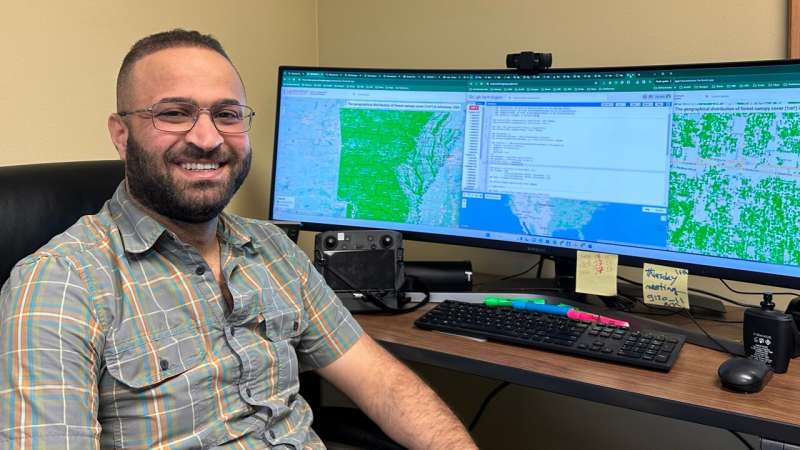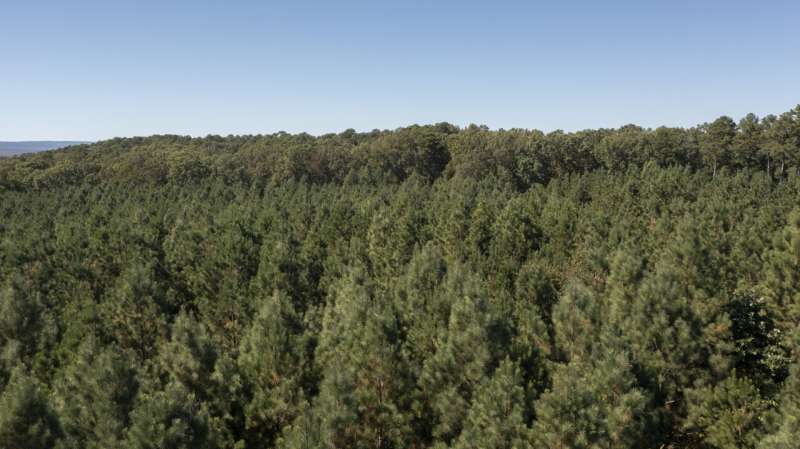This article has been reviewed according to Science X's editorial process and policies. Editors have highlighted the following attributes while ensuring the content's credibility:
fact-checked
trusted source
proofread
Machine learning leads to first regional scale forest mapping using 1-meter measurements

An Arkansas researcher has developed the first high-resolution forest canopy cover dataset for an entire state, providing valuable insights for forest management and conservation to a major economic sector in Arkansas.
"I had this vision of creating something that we can rely on," said Hamdi Zurqani, assistant professor for the College of Forestry, Agriculture and Natural Resources at the University of Arkansas at Monticello and researcher with the Arkansas Agricultural Experiment Station. "No data of this kind existed before for an entire state. Usually, people only create similar data for site-specific projects."
The 1-meter measurements are unique. Until now, the most common forest measurements and datasets have come from satellite imagery at 30-meter spatial resolution, said Zurqani, who conducts research as part of the Arkansas Forest Resources Center, a partnership between the University of Arkansas System Division of Agriculture and UAM. The experiment station is the research arm of the Division of Agriculture.
Forest canopy cover measures the coverage of tree crowns from an aerial view. It shows how much a forest's uppermost layer of branches, leaves and vegetation forms a continuous cover over the ground. This detailed information is crucial for tracking forest health, as canopy cover is essential for carbon sequestration, wildlife habitat and water regulation.
Zurqani says accurate mapping of tree coverage helps scientists monitor and manage forest resources effectively, ensuring the sustainability of these ecosystems. This information can also assist with wildfire risk assessments, tracking forest health threats from pests and climate, and urban planning.
Zurqani's research was published in the journal Remote Sensing Applications: Society and Environment. The article was titled "High-resolution forest canopy cover estimation in eco-diverse landscape using machine learning and Google Earth Engine: Validity and reliability assessment."
According to the latest Arkansas Agricultural Profile, forests cover 57% of the state, and timber was one of the state's top commodities in 2021 with about $409 million in cash farm receipts.

Machine learning
To create the Arkansas forest canopy cover dataset, Zurqani used machine learning techniques and the Google Earth Engine.
Machine learning is a branch of artificial intelligence that allows computers to "learn" from data and improve their performance over time without being programmed. Machine learning algorithms identify patterns in data, make predictions and adapt to new information.
The Google Earth Engine is a cloud-based platform designed for processing and analyzing large-scale geospatial data. It provides access to a vast repository of satellite imagery and geospatial datasets.
Zurqani's research utilized high-resolution National Agriculture Imagery Program aerial imagery to apply and test his methods.
The National Agriculture Imagery Program, administered by the United States Department of Agriculture, captures high-resolution aerial imagery of agricultural areas during the growing season. The imagery is used for monitoring crop conditions, assessing land use changes, and supporting various agricultural and environmental applications.
Room for growth
A finer spatial resolution of Arkansas forests provides a more accurate assessment of canopy structure and composition. Zurqani says this precision is essential for monitoring changes in forest dynamics, identifying vulnerable areas and implementing targeted conservation strategies. Zurqani hopes his 1-meter dataset could become the new standard for measuring forest canopy cover.
"So, in the future, we can use this dataset to cover all forest areas and see which trees are healthy and which ones are diseased," Zurqani said. "Because it's high-resolution imagery, we can detect the location of the trees within urban areas."
There are 502 cities and 75 counties in Arkansas, according to the U.S. Census Bureau, and Zurqani said he evaluated forests and tree-covered areas within those cities and counties. While initially focused on the state of Arkansas, Zurqani envisions expanding this innovative approach to cover all 50 states.
"The studies demonstrate that machine learning and cloud computing technologies can produce reliable, high-resolution forest cover datasets," Zurqani said. "These methods can be applied to other regions globally, enhancing forest management and conservation efforts worldwide."
More information: Hamdi A. Zurqani, High-resolution forest canopy cover estimation in ecodiverse landscape using machine learning and Google Earth Engine: Validity and reliability assessment, Remote Sensing Applications: Society and Environment (2023). DOI: 10.1016/j.rsase.2023.101095
Provided by University of Arkansas



















